Gunabhadra, Guṇabhadra: 5 definitions
Introduction:
Gunabhadra means something in Hinduism, Sanskrit, the history of ancient India. If you want to know the exact meaning, history, etymology or English translation of this term then check out the descriptions on this page. Add your comment or reference to a book if you want to contribute to this summary article.
India history and geography
Source: archive.org: Geography in Ancient Indian inscriptionsGuṇabhadra (गुणभद्र).—The king Guṇabhadra caused to be cut out of the rock the temple of Viṣṇu, which bore the name Mahendra-viṣṇu-gṛha and stood on the bank of Mahendra-taṭāka, situated in Mahedrapura. The city, the tank, and the temple—all were named after Mahedra, the other name of king Guṇabhadra.

The history of India traces the identification of countries, villages, towns and other regions of India, as well as mythology, zoology, royal dynasties, rulers, tribes, local festivities and traditions and regional languages. Ancient India enjoyed religious freedom and encourages the path of Dharma, a concept common to Buddhism, Hinduism, and Jainism.
Languages of India and abroad
Sanskrit dictionary
Source: Cologne Digital Sanskrit Dictionaries: Cappeller Sanskrit-English DictionaryGuṇabhadra (गुणभद्र).—[masculine] [Name] of an author.
Source: Cologne Digital Sanskrit Dictionaries: Monier-Williams Sanskrit-English DictionaryGuṇabhadra (गुणभद्र):—[=guṇa-bhadra] [from guṇa] m. Name of the author of the Ātmānuśāsana.
[Sanskrit to German]
Sanskrit, also spelled संस्कृतम् (saṃskṛtam), is an ancient language of India commonly seen as the grandmother of the Indo-European language family (even English!). Closely allied with Prakrit and Pali, Sanskrit is more exhaustive in both grammar and terms and has the most extensive collection of literature in the world, greatly surpassing its sister-languages Greek and Latin.
See also (Relevant definitions)
Partial matches: Bhadra, Guna.
Full-text: Jinasena, Mahendrapura, Shrimalasutra, Vajramritatantra.
Relevant text
Search found 13 books and stories containing Gunabhadra, Guṇabhadra, Guna-bhadra, Guṇa-bhadra; (plurals include: Gunabhadras, Guṇabhadras, bhadras). You can also click to the full overview containing English textual excerpts. Below are direct links for the most relevant articles:
Buddha-nature (as Depicted in the Lankavatara-sutra) (by Nguyen Dac Sy)
Introduction to the Laṅkāvatāra-sūtra < [Introduction]
Introduction (Hīnayāna and Hindu philosophy) < [Chapter 3 - The Laṅkāvatārasūtra and Hindu Philosophy]
2.2. Chan and the Laṅkāvatāra-sūtra < [Chapter 6 - Further Development of the Thought of Buddha-nature in China]
The Sutra of Queen Śrīmālā of the Lion’s Roar
Maha Prajnaparamita Sastra (by Gelongma Karma Migme Chödrön)
Appendix 5 - The Prakaraṇapāda-śāstra (aka. Prakaraṇagrantha or Prakaraṇa) < [Chapter XXXI - The Thirty-seven Auxiliaries to Enlightenment]
The Paramārthaśūnyatā-sūtra < [Chapter XLVIII - The Eighteen Emptinesses]
Appendix 7 - The seals of the Dharma (dharmamudrā, dharma-mudrā) < [Chapter XXXVI - The eight recollections (anusmṛti or anussati)]
The Fo-Sho-Hing-Tsan-King (A Life of Buddha) (by Samuel Beal)
Lives of Buddha (8): Kwo-hu-hien-tsai-yin-ko-king < [Introduction]
Yogadrstisamuccaya of Haribhadra Suri (Study) (by Riddhi J. Shah)
Chapter 1.4 - From Haribhadrasūri to Hemacandrācārya (Hemachandra) < [Chapter 1 - The Jain Yoga Tradition—A Historical Review]
Chapter 1.8 - The Goal in Jain Yoga < [Chapter 1 - The Jain Yoga Tradition—A Historical Review]
The backdrop of the Srikanthacarita and the Mankhakosa (by Dhrubajit Sarma)
Related products
